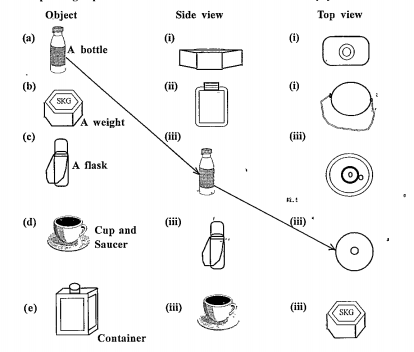Take any quadrilateral, say ABCD , Divide it into two triangles, by drawing a diagonal. You get six angles 1,2,3,4,5 and 6. Use the angle sum property of a triangle and argue how the sum of the measures of and amount to 180∘+180∘=360∘.
 Solution in Assamese
Solution in Assamese
Step by step video & image solution for Take any quadrilateral, say ABCD , Divide it into two triangles, by drawing a diagonal. You get six angles 1,2,3,4,5 and 6. Use the angle sum property of a triangle and argue how the sum of the measures of and amount to 180^@ + 180^@ = 360^@. by Maths experts to help you in doubts & scoring excellent marks in Class 8 exams.
Updated on:21/07/2023Topper's Solved these Questions
Similar Questions
What will be the unit digit of the square of the following numbers?
81
View SolutionFor each of the given solid, the two views are given. Match for each solid the corresponding top and front views. The first one is done for joy.

View SolutionHow many lines of symmetry does the above figure have ?
View SolutionDetermine the point of symmetry of a regular hexagon.
View SolutionDtermine the images of the following figure about the given line :
View SolutionDraw the bisector of ∠AOB=58∘
ltimg src="https://d10lpgp6xz60nq.cloudfront.net/physics_images/PS_MATH_VII_C05_S01_009_Q01.png" width="80%"gt
View SolutionMatch the following Column A to Column B

View SolutionMatch the following Column A to Column B

View SolutionThe sum of four angles of a quadrillateral is 360∘ from the following figure, express the relation between x and y by making x as the subject.
ltimg src="https://d10lpgp6xz60nq.cloudfront.net/physics_images/PS_MATH_VII_C08_E05_016_Q01.png" width="80%"gt
View SolutionMatch the following Column A to Column B

View SolutionThe inequation represented by the graph given below is :
View SolutionThe inequation that best describes the graph given below is _________
View SolutionThe inequation that best describes the following graph is _________
View SolutionIf y-x=180^(@) then find the values of x and y. ltimg src="https://d10lpgp6xz60nq.cloudfront.net/physics_images/ALN_PHY_R05_E01_034_Q01.png" width="80%"gt
View SolutionConsider a quadrilateral, ABCD. (Attached Figure 3.7). Draw a diagonal and divide it into two triangles. You get six angles 1,2,3,4,5 and 6. Use the angle-related property of the triangle and argue how /_A, /_B, /_C And /_D Of measurements 180^@ + 180^@=360^@ The sum is formed.
View Solution
